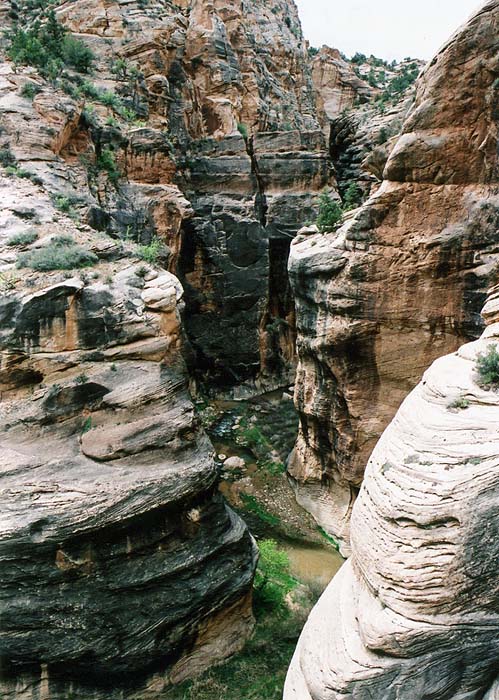ZION CANYON, UTAH
Utah is an outdoor paradise. From any place in the state, there
are outdoor adventures within 15 minutes. Designated in 1919, Zion National Park is Utah's oldest national
park that consists of 229 square miles. Noted for its stunning scenery found nowhere else on earth, Zion Canyon is a geologic showpiece with sandstone cliffs among the highest in the world.
This spectacular cliff-and-canyon landscape and wilderness is full of the unexpected featuring soaring towers, monoliths, arch-shaped rock formations and slot canyons. This
unique geography and the variety of life zones make Zion significant as a place of unusual plant and animal diversity. Wildlife
such as Mule Deer, Golden
Eagles and Mountain Lions
inhabit the Park.
Zion has meant different things to different cultures.
To the Mormon pioneers, it was a haven of beauty
resembling natural temples and they called it "Little Zion" which is an ancient Hebrew word meaning a place of refuge or sanctuary.
The Paiute Indians were superstitious about "I-u-goone" (Zion Canyon) and refused to stay there after dark. They beleived
there were powerful spirits that entered into the canyon when the sun went down. Among
the Paiute tribe there are recordings which the medicine people read as drawings of space ships. The southern Paiutes were the last tribe inhabiting Zion canyon.
One of the mysteries of
Zion Canyon is the Anasazi who were known as the ancient Puebloan people who settled in this canyon over 3000 years ago. They saw Zion Canyon as a doorway into another
dimension to the Star Visitors world. Many researchers believe the Anasazi were
originally brought here by advanced Star Visitors who also removed the Anasazi.
There are various canyons of Zion that are not only mysterious but very magickal with power spots and hundreds of petroglyphys spanning several
cultures. Parunuweap
Canyon of Pauite origin means 'roaring water' and has a number of slot canyon tributaries
that are far from any trailhead and would need at least one overnight stay to
explore. Parunuweap Canyon contains the largest concentration of Anasazi ruins and has the most powerful vortex fields.
Petroglyph Canyon and Southgate
Canyon are rich in rock art petroglyph and high concentrations of negative ions.
The Narrows Canyon is a world attraction with its 13-mile stream-bed hike through a canyon gorge over 2000 feet deep.
Many people hike into these surreal-like canyons that literally become steadily deeper and narrower. As
people travel deeper in these ancient canyons, they experience many
different things. Many people continue to have mystical and spiritual experiences in these canyons that transform their lives.
The Zion Narrows is the centerpiece of Zion National Park and is one of the top river hikes
in Utah. The increasingly popular sport of "Canyoneering" is a term used to describe an adventure sport that combines hiking,
wading, swimming, boulder hopping, rock climbing and rappelling. Most people extend the definition to describe hiking
in a canyon, even if the canyon is flat and dry and does not require any special technical skills. Canyoneering is referred
to as Canyoning virtually everywhere in the world, except in the United States.
The Zion Narrows is the canyon of the East Fork of the
Virgin River, about two thirds of the size of the famous Zion Canyon of the West Fork, but unlike the often crowded Narrows
receives virtually no visitors, partly as the lower half, within Zion National Park, has been closed for many years by the
NPS to protect natural habitats and act as a study area. Luckily, the best part is just outside the park, as here for several
miles the river flows through a beautiful, narrow, thousand foot deep gorge, and although quite difficult to reach, provides
easy walking once inside as there are no major obstacles, just a few deep pools, patches of quicksand and small waterfalls.
The name Parunuweap is of Pauite origin, meaning 'roaring water'. The
larger West Fork Canyon was once known by a similar term, Mukuntuweap, and indeed Zion National Park began life as Mukuntuweap
National Monument, before being renamed in 1918. Parunuweap Canyon is on the East Fork of the Virgin River
is one of the West's finest examples of a flash flood canyon. Its spectacular narrows, twisting side canyons, showy rock formations,
and hanging gardens all qualify Parunuweap for Wilderness Designation. Parunuweap
Canyon is steadily
becoming deeper and in many places very narrow - only 20 or 30 feet wide. This
deep passage can also be dark and gloomy and resides with the noise of rapid waters...
Parunuweap also has a number of slot canyon tributaries
though some are far from any trailhead and would need at least one overnight stay to explore, as would a trip through the
full length of the canyon, though a fair amount can be seen in one long day.
Mineral Gulch is a distant, secluded canyon,
just one of hundreds of narrow gorges in south Utah. It is a tributary of the East Fork of the Virgin River, which after the
confluence flows through its own deep canyon and joins with the West Fork - the river responsible for creating Zion Canyon. The lower one mile of the Gulch has several
lengthy deep, narrow passages enclosed by high red Navajo sandstone cliffs, with patterns of light and erosion similar to
those of Buckskin
Gulch. Reaching the canyon takes some effort - a 3 hour walk along a rough track, down a dry streambed for a half a mile then a
climb down a steep cliff, but the complete solitude and unspoilt surroundings are well worth the trouble.
Misery Canyon, also known as Fat Man's Misery,
this is a relatively short slot canyon that runs from the south side of the White Cliffs near the southeast entrance to Zion
National Park into Parunuweap. It is he deep gorge formed by the East Fork of
the Virgin River. As its long name suggests, Misery is very narrow in places though not continuously so - the upper reaches
have short, deep, enclosed passages of curvy narrows with watery potholes that in some places require rappelling to descend,
separated by longer open parts. All these narrows can easily be bypassed if desired,
apart from the last stretch near the river junction, which is much deeper and protected by a 30 foot dryfall,
but even this can be partially explored without ropes if entering from the lower end at river level.
A stream flows along the lower part of Misery Canyon, forming pools
(with frogs) and small waterfalls, past smooth white striated rocks decorated by patches of bright green vegetation, while
above tower eroded cliffs several hundred feet high. Beyond the pools and past a climb of 5 feet, the canyon closes in and
has narrow, curving chambers linked by sharp eroded fins and a few water-carved arches. It becomes quite dark, has deeper
pools and potholes, one of which is difficult to pass though with a little effort all of this section can be followed. This
is a cool and atmospheric place and all of the canyon, although generally rather dark, is still very pretty.

UPPER
VIEW OF PARUNUWEAP CANYON

